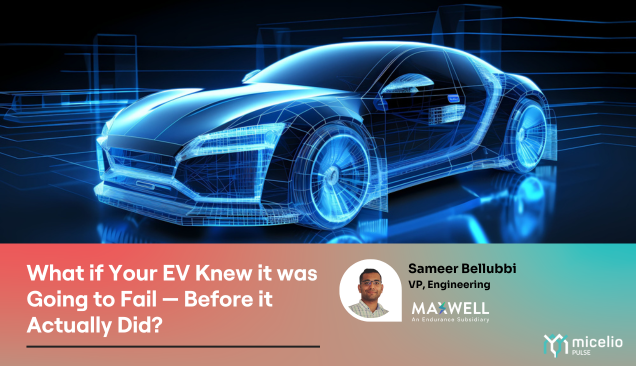Revolutionizing EV Testing: How Power HIL, Digital Twins, and AI/ML Are Shaping the Future of Battery Analysis!
Year 200x—countless nights spent in the office, trying to reproduce production issues. Some of them still haunt me. Maybe you’ve experienced something similar.
The battery wouldn’t deliver power when the user turned the key off and then back on. Really? That’s a basic requirement—how could it fail? Yet, it worked perfectly in our lab. But that didn’t matter. It was failing in the field.
A car with six airbags failed to deploy even one during an actual crash.
The usual response? A war room. Engineers from different suppliers sat around, justifying why their systems worked as expected—under their assumed conditions. But the real world doesn’t follow assumptions.
This is where Power Hardware-in-the-Loop (Power HIL), digital twins, and AI/ML come in. These technologies ensure real-world scenarios are tested before vehicles hit the road, making EVs safer, smarter, and more reliable.

The Limitations of Traditional Testing
Historically, vehicle testing was mostly physical. Real-world prototypes were put through extreme scenarios—crash tests, overheating simulations, short-circuit testing—all of which were costly, time-consuming, and sometimes even dangerous. For example, testing battery safety meant exposing actual battery packs to overheating, short circuits, or even fire. This put vehicles, testing personnel, and timelines at risk. Crash testing was another challenge—each test required a new prototype, and testing could never cover every possible failure mode.
With the rise of electric vehicles (EVs), testing complexity has increased. Battery management and complex electrical systems all introduce new variables. Traditional methods could only cover a fraction of these possibilities, leaving manufacturers vulnerable to unexpected failures once the vehicles were on the road.
Then came Power HIL and digital twins—technologies that changed the game.
Power HIL: Simulating Real-World Stress
Power HIL enables manufacturers to simulate extreme operational conditions without putting real vehicles—or their occupants—at risk. This includes:
- Real-World Stress Testing: Simulating electrical faults, short circuits, overheating, and surges to identify vulnerabilities early.
- Battery Safety Validation: Testing lithium-ion batteries for risks like thermal runaway, short-circuiting, and overheating in a controlled environment. Power HIL allows us to see how safety mechanisms—thermal management, fuses, shutdown features—respond under stress before real-world failures happen.
Power HIL bridges the gap between theoretical safety and real-world conditions, providing manufacturers with actionable insights to improve battery reliability.
Digital Twins: Continuous Monitoring and Predictive Safety
Digital twins have transformed EV safety by enabling:
- Real Time Performance Monitoring: A digital replica of an EV allows manufacturers to track battery health, temperature, voltage, and charge cycles in real time. This helps prevent overheating and degradation before they become critical issues.
- Predictive Failure Detection: Using real-world data, digital twins identify subtle signs of wear or stress in key components. This allows for preventive maintenance and design improvements before failures occur.
- Crash Simulation and Optimization: Instead of relying solely on physical crash tests, digital twins simulate impact scenarios to refine vehicle structures, battery protection, and safety mechanisms.
This real time, predictive approach ensures that failures aren’t just discovered in a war room—they’re prevented long before they can happen.
AI/ML: Smarter, Safer EVs
Artificial intelligence (AI) and machine learning (ML) are making EVs safer by enhancing:
- Smart Safety Features: AI-driven ADAS (Advanced Driver Assistance Systems) features like lane-keeping assist, automatic emergency braking, and collision detection analyze real time sensor data to prevent accidents.
- Battery Safety through Predictive Analytics: Machine learning detects abnormal temperature fluctuations and irregular charging behaviors, enabling early interventions to prevent thermal runaways or fires.
- Predictive Maintenance: AI identifies potential component failures—whether in the powertrain, battery, or braking system—based on historical data, allowing for proactive repairs instead of reactive fixes.
These AI-driven advancements ensure EVs aren’t just smart—they’re continuously learning and improving in real time.
The Synergy of Power HIL, Digital Twins, and AI/ML
When combined, these three technologies create a comprehensive framework for EV safety:
- Holistic Safety Testing: Power HIL tests physical conditions, digital twins provide continuous performance tracking, and AI/ML optimizes decision-making.
- Autonomous Vehicle Safety: AI-driven digital twins refine autonomous EV decision-making, making them safer in unpredictable traffic conditions.
Together, they provide a level of safety assurance that traditional methods simply couldn’t achieve.
A Safer Future for EVs
By integrating Power HIL, digital twins, and AI/ML into the testing process, manufacturers can create safer EVs faster than ever before. From battery safety and crash protection to predictive maintenance, these technologies ensure that EVs are rigorously tested before they hit the road. For consumers, this means peace of mind—knowing that their EVs have undergone extensive, intelligent safety testing designed to prevent failures, accidents, and risks.
As EV technology evolves, these innovations will play a pivotal role in making vehicles not just efficient and sustainable, but safer than ever. The future of EV testing is here—and it’s revolutionizing the way we ensure road safety, one simulation at a time.
(Disclaimer: The views expressed here are solely of the expert. Micelio does not claim ownership and serves only as a platform to share insights from industry leaders)
*****************************************
About Expert:
Sameer Bellubi
Vice President- Engineering, Maxwell Energy Systems
Sameer is an e-mobility expert with over 11 years of experience in embedded software and functional safety. He has led engineering and program management across leading automotive firms including KPIT, A123 Systems, and AMP. Sameer has played a key role in product launches for global OEMs like Daimler, Porsche, and GM. His deep domain expertise continues to shape the evolving landscape of electric mobility.


